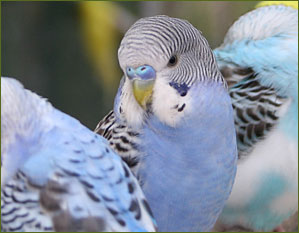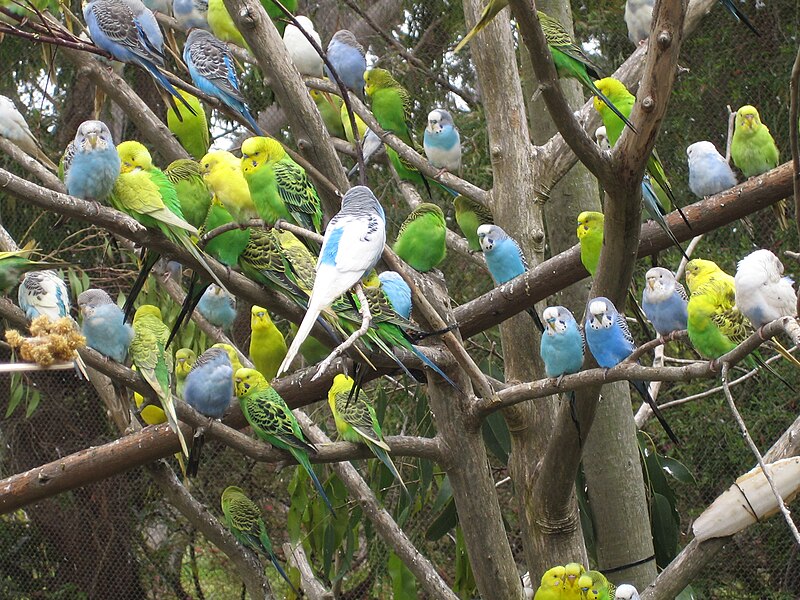I’m often questioned on the pros and cons of keeping Budgerigars (parakeets) and other parrots singly as opposed to in pairs or groups. Most folks are aware that parrots housed alone tend to form strong bonds to their owners, more so than birds that have others of their own kind to interact with. While this may be true to some extent, there are other considerations. A recent question from a bird owner who planned to give away one of her budgies, in order to make a “better pet” of the other, has prompted me to post some thoughts here.
Social Life in the Wild
Parrots, including budgies, almost always fare best when kept in pairs or appropriate groups. Those I have observed in the wild (and this is echoed by all careful parrot-watchers) are in almost constant contact with their mates and flock members. Even in large flocks, and during flight, it is usually quite a simple matter to spot paired birds…they remain, literally, within touching distance of one another.
Solitary Pets
A great many of the problems experienced by pet parrots are related to their being kept alone. The agitated “dances”, displays and attacks on toys exhibited by solitary birds, and which are found amusing by those unfamiliar with parrot biology, are actually born of frustrated urges to mate and defend a territory. Several parrot interest groups have now published position statements to the effect that housing a parrot alone is, in most cases, considered by the group to be animal abuse.
Filling in for a Missing Mate
I advised the afore-mentioned budgie owner that while the bird may indeed form a strong bond with her if kept alone. However there would be no way to predict such, as her pet had already been housed with another bird (this will affect its reaction to being kept alone).
But above all, the most important consideration to bear in mind is that spending a few hours each day with a budgie would not be adequate; parrots kept alone need the near constant companionship of a person if that person is to be considered a “substitute” for the missing mate. This is difficult to arrange for most people.
Further Reading
Parrots that bond with people may make wonderful pets but sometimes raise a host of unexpected problems. For more information, please see another article I have written, Parrot Bonding: Positive and Negative Aspects.
 That Bird Blog – Bird Care and History for Pet Birds
That Bird Blog – Bird Care and History for Pet Birds

 English Budgerigars, or budgies, are sometimes referred to as “show or exhibition budgerigars”. They are stouter than the “American Budgerigar”, which is also known by the common name of “parakeet”. Both are larger than wild budgerigars – twice as large in the case of the English race.
English Budgerigars, or budgies, are sometimes referred to as “show or exhibition budgerigars”. They are stouter than the “American Budgerigar”, which is also known by the common name of “parakeet”. Both are larger than wild budgerigars – twice as large in the case of the English race.

 Budgerigars should be offered a mix of seed based (i.e.
Budgerigars should be offered a mix of seed based (i.e.  The budgerigar (or “budgie”), more commonly referred to as “parakeet” in the USA, is undoubtedly the most commonly kept parrot, if not bird, in the world. In fact, many think of the budgerigar as a purely domesticated species, and know little of its existence in the wild. Yet it is Australia’s most numerous parrot, and arguably the most abundant bird on the continent. Today we will take a look at how it lives in the wild, followed by notes on captive care next time.
The budgerigar (or “budgie”), more commonly referred to as “parakeet” in the USA, is undoubtedly the most commonly kept parrot, if not bird, in the world. In fact, many think of the budgerigar as a purely domesticated species, and know little of its existence in the wild. Yet it is Australia’s most numerous parrot, and arguably the most abundant bird on the continent. Today we will take a look at how it lives in the wild, followed by notes on captive care next time.